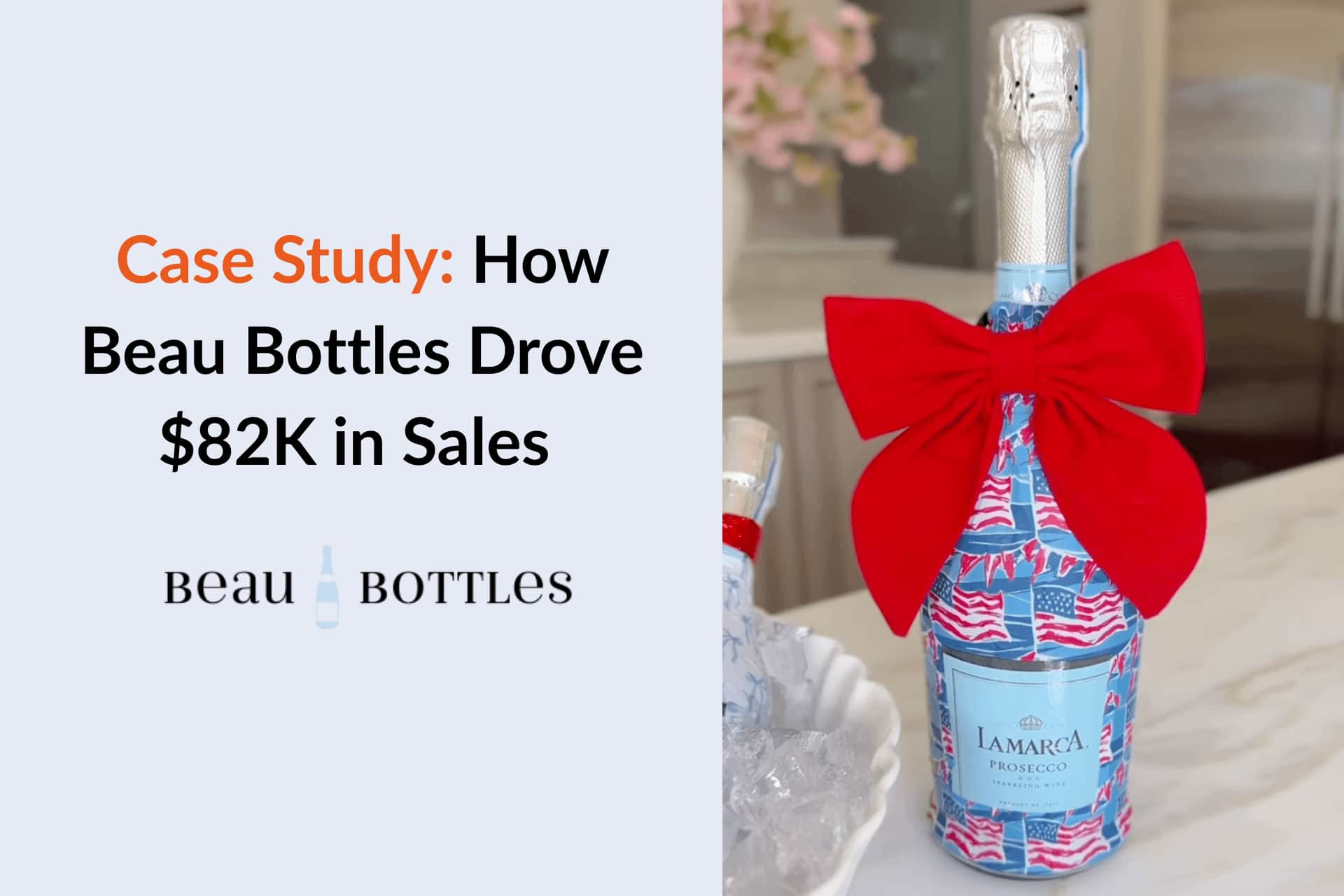





Klarna has become a well-known name in the payment industry, offering buy now, pay later (BNPL) services to help consumers manage their purchases. However, users have expressed concerns about Klarna's high late fees, lack of clear transparency in billing, and occasional difficulties with customer service. These issues have prompted many to seek alternative solutions that offer greater flexibility, better customer support, and more transparent pricing structures.
In this article, we will explore the top 10 Klarna alternatives, including popular platforms like Influencer Hero, Modash, and Upfluence, each offering distinct features to enhance your influencer marketing efforts and payment flexibility.
Many users have expressed frustrations with Klarna, prompting them to seek alternative platforms that better meet their needs. Common concerns include difficulties with identity verification, unexpected late fees, and inconsistent customer support. These issues have led consumers to explore other options that offer more reliable and user-friendly experiences.
A significant number of users have reported persistent issues with Klarna's identity verification process. Despite having accounts in good standing, many find themselves unexpectedly denied access due to verification problems. This recurring issue has been highlighted in various user reviews and discussions, with some customers feeling that their concerns are not adequately addressed by Klarna's support team.
Users have expressed frustration over Klarna's late fees, which they feel are applied even when payments are made promptly. Some customers have reported that despite paying on time, they received notices about late fees, leading to confusion and dissatisfaction. This has raised concerns about the transparency and fairness of Klarna's fee structure.
Many users have found Klarna's customer support to be lacking in responsiveness and effectiveness. Reports indicate that issues raised by customers are often not resolved in a timely manner, and some users have had to escalate their concerns multiple times without satisfactory outcomes. This inconsistency has led to a diminished trust in Klarna's commitment to customer service.
Some users have noted that Klarna's payment options lack the flexibility offered by other platforms. For instance, certain payment methods are not always available at checkout, and users have expressed a desire for more diverse payment scheduling options to better align with their financial situations.
Our comparison focuses on several key aspects:
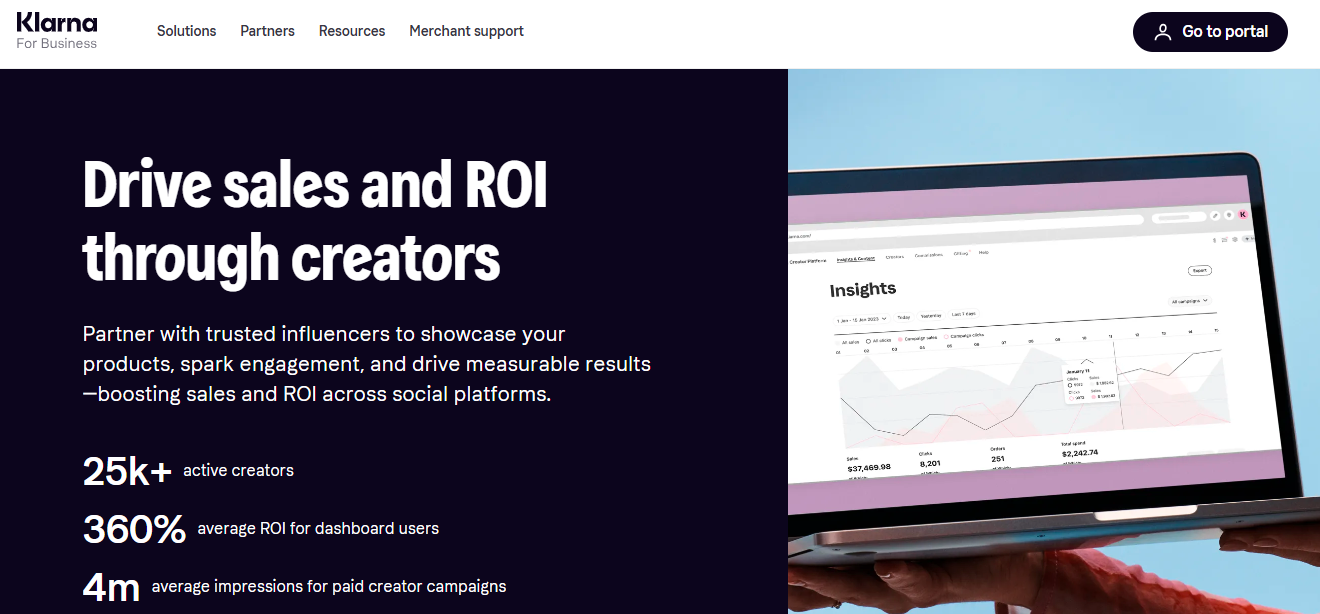
Best For: Klarna is best for eCommerce brands looking to scale influencer and affiliate campaigns across multiple platforms using a performance-based commission model.
Platform Coverage:
Pricing: Based on our research, Klarna operates on a performance-based commission model, where brands only pay for actions and sales driven by creators. Specific commission rates, share splits, and minimum spends are not publicly disclosed and must be negotiated directly with Klarna. There are no setup fees for brands.
Reviews: 4.6 / 5.0 (Capterra)
Ease of Use (UX/UI): Users have praised Klarna for its clean, intuitive interface that simplifies managing influencer marketing campaigns. Many have highlighted the ease with which brands can track their performance and monitor creator-generated sales. However, some users noted a learning curve when initially setting up and optimizing campaigns, especially due to the platform's global rollout.
Customer Support: Klarna's customer support is highly regarded for its responsiveness and helpfulness. Users appreciate the clarity provided by support teams, especially when navigating new features or troubleshooting issues. However, there have been some reports of delays during peak periods, and certain regions still experience limited support options.

Best For: Influencer Hero is ideal for growing D2C brands and eCommerce teams looking for an all-in-one platform to scale influencer marketing campaigns. It excels in managing influencer relationships across multiple social media platforms while delivering deep insights and automation tools.
Platform Coverage:
Pricing: Influencer Hero offers flexible pricing plans to accommodate growing brands. All plans include core features and can scale as the influencer program grows.
Reviews: 5.0 / 5.0 (Capterra)
Ease of Use (UX/UI): Influencer Hero is known for its intuitive design and user-friendly interface, with a streamlined dashboard that simplifies the management of influencer campaigns. The platform offers automated workflows and customizable email templates that save time, helping teams to move quickly without extensive training.
Customer Support: Influencer Hero provides exceptional customer support, with 24/7 real-human live chat, responsive email support, and a comprehensive Help Center full of written and video tutorials. Every plan includes a dedicated account manager from day one, with optional strategy consultations to guide growth. Pro plan users also receive access to a private Slack channel for quicker, continuous support.
Klarna follows a performance-based commission model where brands pay only for actual sales driven by creators. There are no upfront setup fees, but pricing transparency is limited, and commission rates need to be negotiated directly. In contrast, Influencer Hero offers tiered monthly pricing plans starting at $649/month with clear features and the ability to scale with your brand’s needs.
While Klarna supports cross-channel content and shoppable video features, its primary focus is on performance marketing with its affiliate links. Influencer Hero provides multi-platform support across social networks like Instagram, TikTok, YouTube, and more, offering robust CRM features, AI-powered outreach, and seamless eCommerce integration for better campaign management.
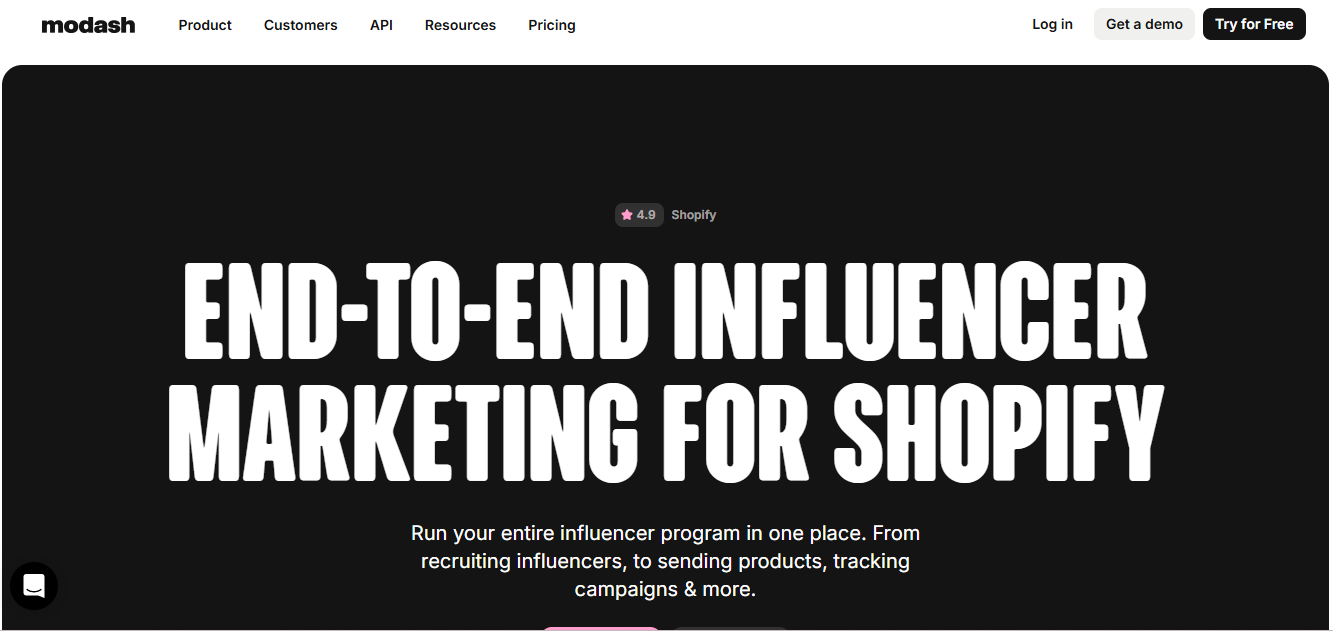
Best For: Modash is best suited for brands seeking scalable influencer marketing campaigns with end-to-end solutions for influencer discovery, outreach, and management. It’s ideal for eCommerce brands using Shopify and looking for robust affiliate and content tracking.
Platform Coverage:
Pricing: There are different plans and options.
Reviews: 4.7/5 (G2)
Ease of Use (UX/UI): Users often highlight Modash’s easy-to-navigate interface, which simplifies influencer discovery and campaign management. With features like bulk outreach options, real-time campaign tracking, and integration with Shopify, the platform provides an efficient workflow that allows brands to focus more on scaling campaigns. The CRM for tracking influencer communications is intuitive, making it a popular choice for teams at all experience levels.
Customer Support: Modash is praised for its responsive customer support, with a dedicated account manager providing tailored guidance to clients. They offer email and WhatsApp support, ensuring a quick resolution of issues. The platform also includes an onboarding process, allowing brands to get up to speed with its features and maximize campaign performance.
Klarna operates on a performance-based commission model, where brands pay creators based on actual sales generated. This pay-per-performance model means no upfront fees but lacks pricing transparency and requires direct negotiations. Modash, on the other hand, offers monthly subscription plans, including the Essentials plan at $199/month and the Performance plan at $499/month, providing more predictable pricing without hidden fees.
Modash provides a more comprehensive influencer management system that includes AI-powered discovery, real-time campaign tracking, and integrations with Shopify for affiliate sales and gifting. Meanwhile, Klarna focuses on commerce integration, with tools like shoppable content, creator storefronts, and an affiliate network, positioning itself as more sales-driven.
Modash may be a better option for brands looking for an all-in-one solution for influencer discovery, outreach, and affiliate tracking with predictable pricing. Klarna, however, might be ideal for brands that want a performance-driven, commission-only model with deep commerce integration and global scalability for retail partners.

Best For: Captiv8 is ideal for enterprise-level brands looking to scale influencer marketing with advanced campaign management, competitive intelligence, and deep performance tracking. It’s best suited for large organizations with the need for in-depth analytics and collaborative workflows.
Platform Coverage:
Pricing: There are different pricing options:
Reviews: 4.1/5 (G2)
Ease of Use (UX/UI): Captiv8 is known for its robust interface that allows for detailed search filters, advanced campaign management, and collaborative features. However, users have noted that its learning curve can be steep, particularly for smaller teams or those new to influencer marketing. The drag-and-drop metric customization makes the reporting process more intuitive once the user is familiar with the platform.
Customer Support: Captiv8 has faced mixed reviews regarding customer support, with some users reporting poor responsiveness and payment issues. However, enterprise-level clients tend to receive more tailored attention, with onboarding services to help set up campaigns. Despite this, many users find their customer service to be lacking, particularly in terms of account issues and delayed payments.
Klarna operates on a performance-based commission model, where brands only pay for sales generated by creators, making it an attractive low-risk option with no upfront fees. However, pricing specifics, including commission rates, require direct negotiation with Klarna. On the other hand, Captiv8 is expensive, requiring a $25K annual commitment, with $3K onboarding fees, and an additional $20–30K per month for storefront and affiliate features.
Captiv8 stands out with its deep campaign tracking, including ROAS, EMV, and word clouds, offering powerful insights into campaign success. It also provides collaborative tools for managing influencer relationships and campaigns at scale. Klarna, however, focuses on sales-driven campaigns, with its shoppable content and creator storefronts, making it more suitable for commerce-centric brands looking for performance marketing.
Captiv8 is better suited for large enterprise brands that need advanced reporting, influencer collaboration, and competitive intelligence, and are willing to commit to a higher cost. Klarna, on the other hand, is ideal for brands focused on performance marketing, especially those looking for low upfront costs and a pay-per-sale model.

Best For: CreatorIQ is ideal for enterprise-level brands looking for an all-in-one influencer marketing platform that manages the entire influencer lifecycle—from discovery to campaign management, reporting, and creator payments. It’s especially useful for large brands seeking to work with top-tier influencers across major platforms like Instagram, TikTok, and YouTube.
Platform Coverage:
Pricing: There are different plans:
Reviews: 4.7/5 (G2)
Ease of Use (UX/UI): CreatorIQ is known for its intuitive interface and advanced filtering capabilities that allow users to easily search and manage influencers. The platform’s customizable reporting and campaign management tools help brands streamline their processes, though some users note the learning curve for beginners. Once set up, the drag-and-drop reporting features and automated workflows make it easy to handle complex campaigns.
Customer Support: CreatorIQ provides excellent customer support, with a dedicated implementation manager and a customer success team offering strategic guidance. Users appreciate the personalized attention during the onboarding process and ongoing quarterly planning support. Many brands report that the hands-on assistance helps maximize the platform’s capabilities.
Klarna operates on a performance-based commission model, meaning brands only pay for sales generated by creators, offering a low-risk approach with no upfront fees. On the other hand, CreatorIQ requires an annual contract with pricing starting at $2K–$5K/month, making it a more predictable, upfront investment for enterprise-level brands that need a comprehensive platform with advanced features.
CreatorIQ offers end-to-end influencer management, including AI-powered discovery, real-time reporting, creator payments, and customizable campaign management. In comparison, Klarna focuses on performance marketing, with features like shoppable content and creator storefronts, emphasizing sales-driven campaigns and affiliate integration.
CreatorIQ is the better choice for large enterprises looking for a comprehensive platform that integrates discovery, campaign management, real-time analytics, and payments. Klarna, however, is more suited for brands focused on performance-based models, particularly those who want a low-entry cost and scalable, commission-only campaigns.

Best For: HypeAuditor is best for brands looking for advanced influencer discovery tools and eCommerce integration, especially those who want to leverage AI-powered insights for social listening and campaign performance tracking. It is particularly well-suited for brands that need high-quality influencer data and prefer customizable reporting for tracking both engagement and eCommerce ROI.
Platform Coverage:
Pricing: HypeAuditor’s pricing is customizable, with the standard “Business” plan starting at around $10,000/year. Pricing can be adjusted based on the number of reports, active campaigns, and platform usage. They also offer a 24–48 hour free trial for new users.
Reviews: 4.6/5 (G2)
Ease of Use (UX/UI): Users find HypeAuditor's interface intuitive with advanced filtering options that allow for detailed influencer discovery. The AI-powered search and content-based categorization simplify finding the right influencers. However, some users mention that the platform is complex for beginners and may require onboarding or training to fully utilize all its features. Once familiar, navigating through the CRM and campaign management tools is straightforward.
Customer Support: HypeAuditor is noted for its responsive customer support and 24/48-hour free trials, allowing users to test the platform before committing. The platform also provides onboarding support and campaign tracking assistance. Some users report the need for more hands-on training during the initial phase to make the most of the tool’s capabilities.
Klarna operates on a performance-based model, where brands pay based on sales generated by creators, offering a low-risk way to scale campaigns. However, its commission rates and terms are not publicly disclosed. In comparison, HypeAuditor requires a $10,000/year base cost for its Standard plan, with additional pricing for extra features, providing customizable options but higher upfront costs.
HypeAuditor excels in influencer discovery with AI-powered tools and detailed audience metrics, integrating with Shopify for eCommerce tracking. Klarna, focused on performance marketing, allows brands to track affiliate sales and shoppable content but lacks the in-depth analysis and reporting that HypeAuditor provides.
HypeAuditor is ideal for brands needing advanced discovery and detailed tracking, while Klarna suits performance-driven campaigns focused on sales through shoppable content.

Best For: GRIN is best for eCommerce brands, especially those in DTC (Direct-to-Consumer) businesses, looking to manage end-to-end influencer marketing. The platform excels in affiliate tracking, gifting, and content management, making it ideal for brands seeking to streamline their influencer relationships, product seeding, and performance-based campaigns.
Platform Coverage:
Pricing:
Reviews: 4.5 / 5.0 (G2)
Ease of Use (UX/UI): Users generally find GRIN intuitive and easy to use, especially for eCommerce-focused brands. The platform offers an all-in-one solution for managing influencer campaigns, from discovery to payment. While the interface is clean and accessible, some users note that the advanced features like affiliate tracking and CRM may require some initial setup to get the most out of the platform.
Customer Support: GRIN’s customer support is widely praised for its responsive and knowledgeable team. Brands can expect tailored support during onboarding and campaign execution. However, some users report occasional delays in response times, particularly for more technical issues. Dedicated program strategists are available for brands opting for hands-on support.
Klarna uses a performance-based pricing model, meaning brands only pay based on actual sales generated by creators through affiliate links. This low-risk model is ideal for brands looking to scale with predictable ROI. In contrast, GRIN follows a subscription-based pricing model, starting at $2,500/month, with 12-month contracts. While GRIN offers more comprehensive features like creator CRM, gifting, and affiliate tracking, the upfront cost may be a barrier for smaller brands.
GRIN stands out with its end-to-end influencer marketing solution, offering seamless eCommerce integrations (like Shopify), affiliate tracking, and a robust CRM for managing creator relationships. Klarna, on the other hand, is more focused on performance marketing, offering shoppable content and creator storefronts, while its main strength lies in its performance-based model.
If you are a DTC or eCommerce brand looking for a comprehensive influencer marketing platform with advanced affiliate tracking and integrations, GRIN is the better choice. However, if your focus is on low-cost, performance-based influencer campaigns, particularly with shoppable content, Klarna may be a better fit for your needs.
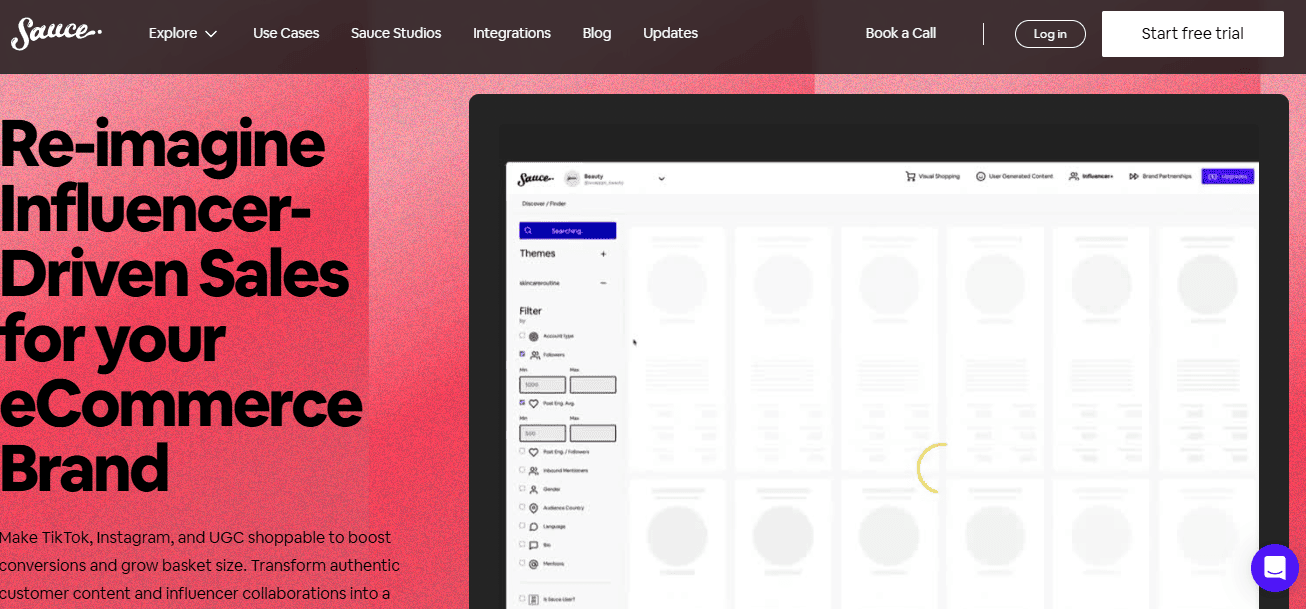
Best For: Sauce is best for eCommerce brands that want to integrate influencer content and user-generated content (UGC) directly into a shoppable experience. It’s especially effective for brands looking to drive conversions by turning social engagement (from platforms like Instagram and TikTok) into sales through visual galleries, video commerce, and shoppable content.
Platform Coverage:
Pricing: Based on our research, Sauce offers different plans. All plans include a 7-day free trial with the option to switch or cancel anytime.
Reviews: 4.6 / 5.0 (G2)
Ease of Use (UX/UI): Sauce is praised for its visual-first design and easy-to-use interface, making it simple for brands and marketers to set up and implement shoppable galleries and video content. The platform integrates smoothly with Shopify and Instagram/TikTok, and allows users to embed content without needing technical skills. However, some users note that the pricing structure based on impressions may require careful monitoring to manage costs effectively.
Customer Support: Sauce offers responsive customer support, including live chat, and is noted for its helpful onboarding and guidance during setup. Users appreciate the zero-code setup, which makes it easy for non-technical teams to get started. Some users have pointed out that, while support is responsive, it can take longer for complex queries to be resolved.
Klarna uses a performance-based pricing model, where brands pay only for sales generated by creators through affiliate links, making it ideal for performance-driven campaigns. In contrast, Sauce follows a tiered pricing model based on impressions, ranging from $50/month to $2,000/month for Enterprise solutions. While it offers a free trial, costs scale with success, making it harder to predict than Klarna’s commission-based system.
Sauce specializes in turning UGC and influencer content into shoppable experiences with a focus on visual shopping galleries and video commerce. Klarna, on the other hand, emphasizes sales-driven marketing with affiliate links and creator storefronts.
If you aim to scale sales through visual UGC experiences, Sauce is the better choice. Klarna works best for performance-based campaigns with low upfront costs.
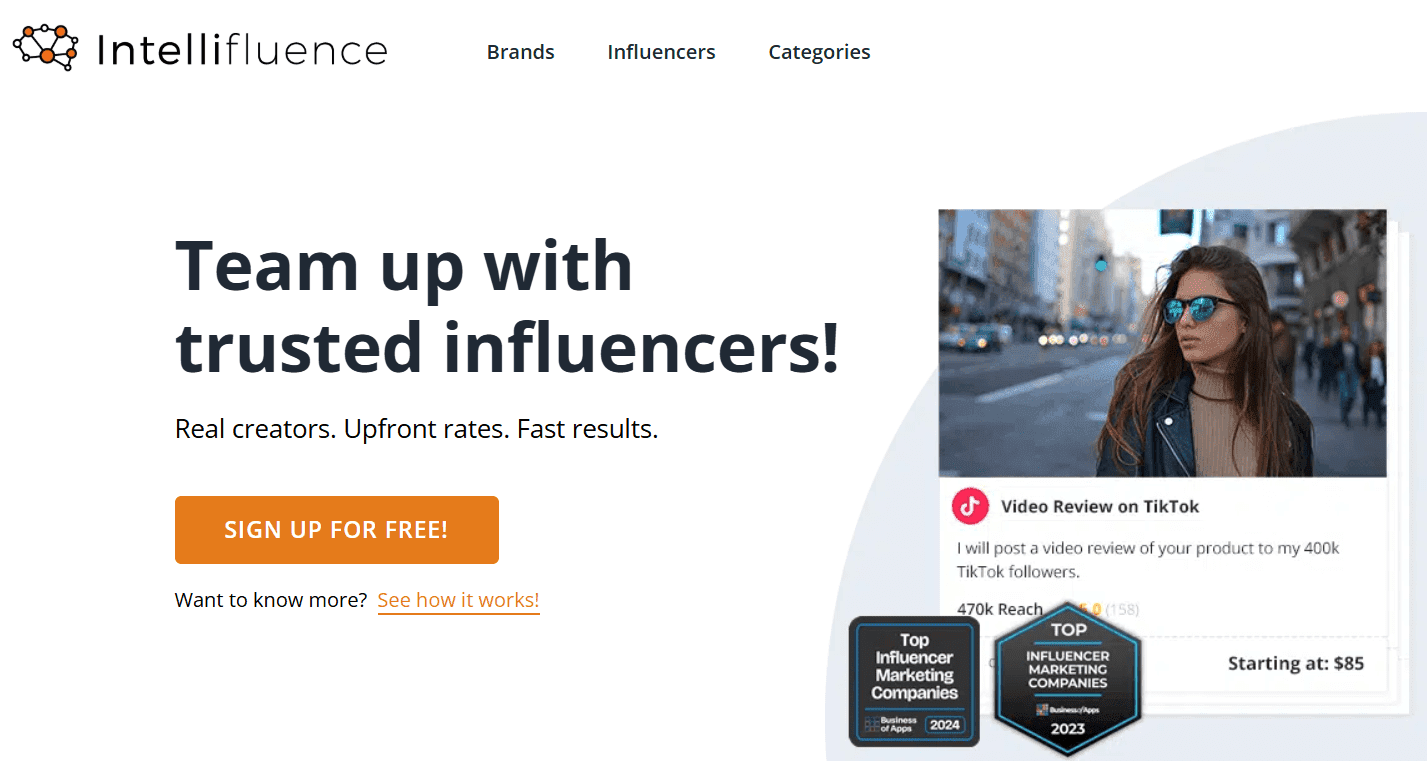
Best For: Intellifluence is best for small to medium-sized brands looking for a flexible and scalable influencer marketing platform. It’s especially effective for brands seeking to engage micro- and nano-influencers, generate UGC (user-generated content), and product reviews across multiple platforms without the need for long-term commitments.
Platform Coverage:
Pricing: Based on our research, there are different options and pricings:
Reviews: 3.9/5.0 (G2).
Ease of Use (UX/UI): Intellifluence is widely recognized for its user-friendly interface that simplifies the process of influencer discovery and campaign management. Users appreciate the clean dashboard and straightforward workflows, making it easy to manage multiple campaigns and influencer communications. However, some users have noted that the platform can occasionally suffer from minor bugs, and the mobile experience might not be as smooth as the desktop version.
Customer Support: Intellifluence’s customer support is praised for being responsive and providing helpful resources such as tutorials and beginner guides. The team is knowledgeable and offers quick resolutions, especially for general inquiries. However, users have reported that dispute resolution and campaign approvals can take longer than expected, particularly during high-volume periods.
Klarna operates on a performance-based model, where brands pay only for the sales driven by influencers. This model offers low upfront costs and allows brands to scale campaigns based on performance. In contrast, Intellifluence offers a subscription-based pricing model starting at $99/month for small brands, with no long-term contracts. While Klarna’s model is ideal for performance-driven marketing, Intellifluence provides more flexibility and control for brands testing and scaling campaigns over time.
Intellifluence stands out with its Influencer Offers Marketplace, which speeds up collaborations with fixed pricing and makes the process more transparent. Klarna focuses on shoppable content with affiliate links, creator storefronts, and product seeding, emphasizing sales-driven results and performance analytics. Intellifluence offers more flexibility and less rigid structure for influencer campaigns.
Klarna is ideal for performance-focused brands that want to pay only for actual sales driven by creators. If you’re looking for a flexible platform with no long-term contracts, Intellifluence is a better fit, especially for small to medium-sized brands that want to work with micro-influencers and generate UGC across multiple platforms.

Best For: Upfluence is perfect for eCommerce brands, particularly those on Shopify and Amazon, looking to scale influencer marketing campaigns and integrate affiliate tracking with sales. It’s ideal for brands wanting a comprehensive platform to manage influencer discovery, outreach, and campaign tracking.
Platform Coverage:
Pricing:
Reviews: 4.5/5 (G2)
Ease of Use (UX/UI): Upfluence is praised for its user-friendly interface, making it easy for brands to navigate through influencer discovery, outreach, and campaign management. The advanced filters and AI-powered campaign assistant, Jace AI, streamline influencer selection and outreach processes, allowing for more personalized and efficient interactions. Despite its comprehensive features, some users note a learning curve for new users.
Customer Support: Upfluence offers excellent customer support, with dedicated account managers and email/WhatsApp assistance to ensure smooth communication and campaign execution. The platform’s support team is described as responsive and proactive, helping users maximize the platform’s potential through tailored onboarding and educational resources.
Klarna offers a performance-based commission model, meaning brands only pay based on actual sales driven by influencers, providing a low entry cost with no setup fees. However, Klarna’s pricing transparency is limited, requiring brands to negotiate commission rates directly. Upfluence, on the other hand, provides predictable pricing with a monthly subscription of $1,276, including all core features like influencer discovery, outreach, and affiliate tracking. Upfluence’s pricing is higher but offers a comprehensive suite of tools with no commission fees based on sales or outreach.
Upfluence stands out with its all-in-one solution for eCommerce brands, integrating seamlessly with Shopify and Amazon to track affiliate sales, manage product gifting, and offer advanced influencer analytics. Klarna focuses on sales-driven campaigns, with features like shoppable content and creator storefronts, and its multi-platform integration is more suited for brands with a strong focus on performance marketing.
Brands seeking a comprehensive, all-in-one platform for managing influencer relationships, tracking affiliate sales, and leveraging advanced analytics may prefer Upfluence, especially for those on Shopify or Amazon. However, Klarna might be more suited for those who prefer a performance-based model and a lower upfront investment, especially if their focus is on shoppable content and global retail integration.
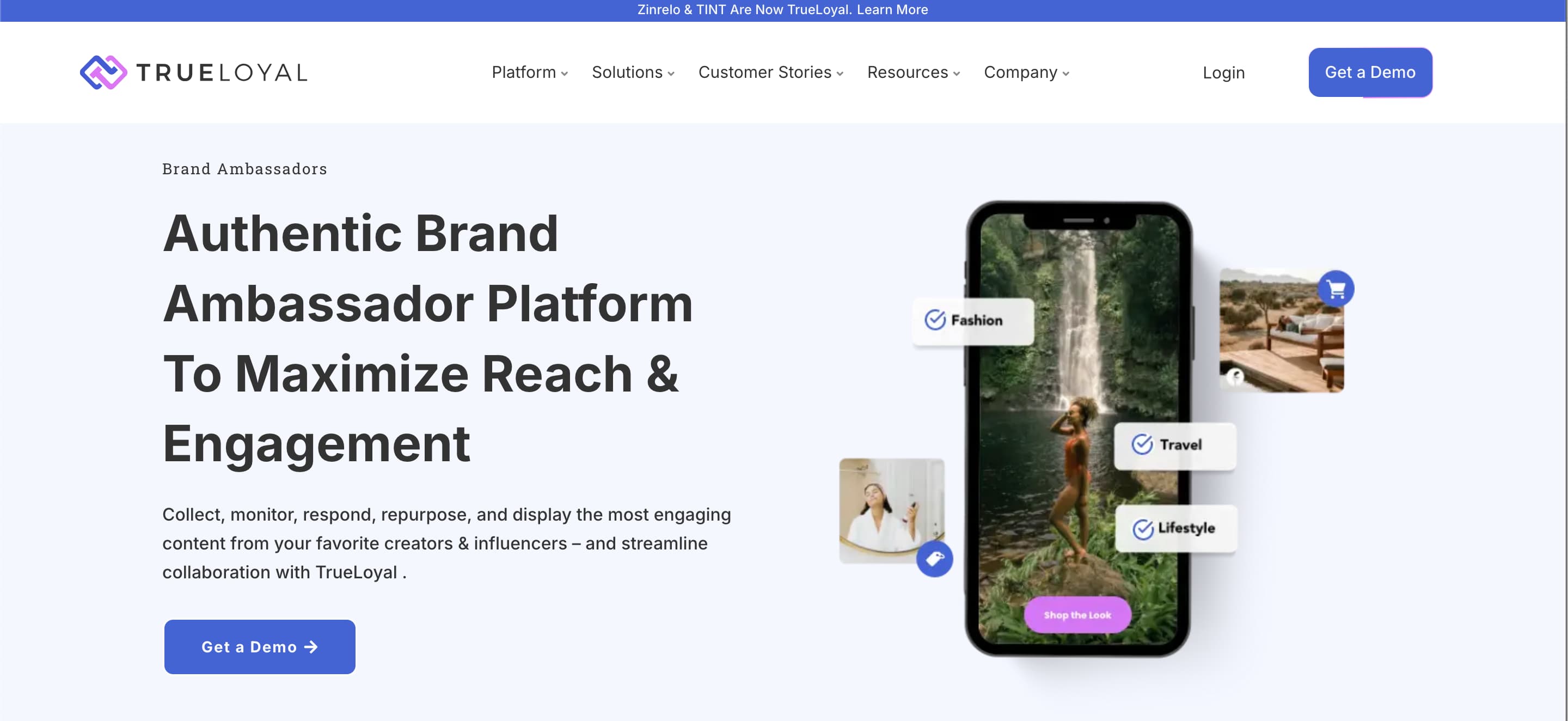
Best For: TrueLoyal is best for **brands looking to build long-term relationships with brand advocates and influencers. It is particularly ideal for eCommerce brands that want to engage with their loyal customers, create social proof from UGC (user-generated content), and scale influencer collaborations in an authentic, streamlined manner.
Platform Coverage:
Pricing: Undisclosed.
Reviews: 4.3 / 5.0 (G2)
Ease of Use (UX/UI): TrueLoyal’s user interface is described as simple and intuitive, designed to support end-to-end influencer and customer content management. Brands can easily create campaigns, set up briefs for influencers, collect and moderate content, and track performance from a single platform. The platform’s integration with eCommerce tools such as Shopify and WooCommerce makes it highly convenient for eCommerce businesses to activate influencer content across multiple channels.
Customer Support: TrueLoyal offers responsive and knowledgeable customer support with hands-on assistance from strategists who can help brands find the right influencers and set up campaigns. Users appreciate the personalized guidance, especially for new users unfamiliar with influencer marketing. Some have mentioned that support during peak times can experience slight delays but have been satisfied overall with the quality of responses.
Klarna uses a performance-based pricing model, where brands pay only for sales-driven results through affiliate links. This low-risk model is great for brands seeking measurable ROI. TrueLoyal, in contrast, does not disclose pricing but offers full-service influencer management, focusing on authentic collaborations and UGC collection for eCommerce brands.
TrueLoyal specializes in streamlining influencer collaboration, with features like content centralization, rights management, and social proof integration. Klarna focuses on shoppable content, creator shops, and cross-platform distribution, paying based on sales commissions.
For long-term influencer partnerships and UGC integration, TrueLoyal is ideal, especially for brands using Shopify or WooCommerce. For performance-based marketing with low upfront costs, Klarna is the better fit.
When considering alternatives to Klarna, it's crucial to focus on platforms that offer performance-based pricing, shoppable content, and seamless integrations for eCommerce brands. Klarna's strength lies in its low-risk pricing model, where brands only pay for affiliate-driven sales through influencer partnerships. However, depending on your business goals, platforms like Influencer Hero offer more comprehensive influencer management features, including advanced CRM, AI-powered influencer discovery, and detailed reporting.
Choosing the right influencer marketing platform depends on your needs—whether you prioritize shoppable content with a performance-based model or advanced campaign management with a full-service influencer solution. Influencer Hero not only competes with Klarna but also provides a deeper level of automation and personalized support.
If you’re ready to explore how Influencer Hero can elevate your influencer marketing, book a demo today and take the first step toward transforming your brand’s digital strategy!

Performance-based platforms allow you to pay only for results (sales or conversions), ensuring that your marketing spend is tied directly to measurable outcomes.
Influencer Hero offers a broader suite of tools for campaign management, including AI-powered influencer discovery, CRM features, and comprehensive reporting. Klarna focuses more on shoppable content and affiliate marketing.
Yes, Influencer Hero seamlessly integrates with major eCommerce platforms like Shopify, WooCommerce, and BigCommerce, enabling you to track affiliate sales and influencer campaigns easily.
Klarna is ideal for performance-driven brands looking to engage influencers and only pay for affiliate sales generated through campaigns.
You can book a demo through the Influencer Hero website to get a personalized walkthrough of the platform’s features and how it can be tailored to your brand’s influencer marketing needs.



Schedule a Demo with one of our media experts below.